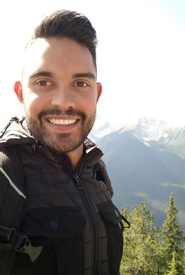Dive into Grand Cayman's pristine waters

Me diving in Grand Cayman (Photo by Rick Lambert)
In April, I went on a week-long scuba diving trip to Grand Cayman with 12 other members of a Toronto-based scuba diving club I belong to. While I had been diving in the Caribbean Sea several times before this trip, this was my first time doing it in the pristine, crystal-clear waters surrounding the Cayman Islands.
We did two to three dives daily, each lasting about 40 minutes to an hour, and went to depths of between 15 and 33 metres. During our dives, we had incredible encounters with many marine species.
Lighthouse Wall
Probably my favourite dive of the week was at a dive site called Lighthouse Wall. This site is so named because of the nearby lighthouse and the massive, 20-metre tall underwater rock wall covered in various corals and sponges.
Throughout the dive, I felt like I was flying alongside a mountain. As I was swimming along the wall, looking for any critters hiding in crevices, I turned my head and spotted a seven-foot-long reef shark! I couldn’t contain my excitement, as this was my first time seeing a wild reef shark. I instantly began following the majestic creature, hoping to get as close to it as possible while still keeping a respectful distance. After a couple of minutes, it disappeared into the blue.
The reef shark we saw on the dive (Video by Rick Lambert)
The USS Kittiwake

Diving next to the USS Kittiwake (Photo by Rick Lambert)
Our eighth dive of the week was a shipwreck dive. As this was my first time doing this type of dive, I was thrilled! The 77-metre-long USS Kittiwake was originally used in World War Two. After the U.S. donated the ship to the Cayman Islands in 2010, it was intentionally sunk to create an artificial reef.
After descending, we briefly swam around the ship and snapped some photos. We then followed our dive guide through a narrow passageway into the vessel’s interior. Because the ship was tilted slightly, I felt somewhat disoriented going through its narrow passageways into its dark rooms, but the adrenaline rush made the experience worth it.
After we left the ship, I noticed hundreds of tiny, slender creatures popping their heads out of holes in the surrounding sand. I dove down to take a closer look and identified them as garden eels. When I got too close, however, they quickly retreated into their holes.
Swimming around the USS Kittiwake (Video by Rick Lambert)
A dive into darkness
On my sixth day, I did my first night dive. We left the resort at sunset and travelled for a few minutes by boat to reach the site. The dive staff gave us special flashlights that had regular, black and red light settings.
With our flashlights on, we entered the pitch-black water. Tons of sea anemones were anchored to the reef and glowed bright green or purple when we shone our black lights on them.
A sea anemone glowing purple when we illuminated it with a black light (Video by Rick Lambert)
As my dive buddy and I further explored the reef, we came across a small, blue-coloured octopus, which quickly changed colour as a defense mechanism and hid in a tiny rock crevice. Before our dive, one of the dive guides told us that if we wiggled one of our fingers in front of an octopus, it might wrap one of its tentacles around it. My dive buddy and I both tried this, but the octopus just wasn’t interested. During this dive, we also saw a stingray and spotted moray eel.

Coral reef (Photo by Madison Busker)
My only complaint about this dive was the swarms of bloodworms (don’t worry — they’re not as scary as their name suggests). Attracted to the light from our flashlights, these tiny red worms swarmed around us, reminding me of underwater gnats; harmless, but annoying.
Overall, I thoroughly enjoyed diving in the waters surrounding Grand Cayman. Diving is my favourite way to immerse myself in nature, and I strongly encourage fellow nature lovers to try it. I like to think of it as “underwater hiking” because, like hiking, it involves exploring natural areas.
Unfortunately, many of the world’s coral reefs are in trouble. Experiencing them has helped me better appreciate their biodiversity and the need to protect them.


